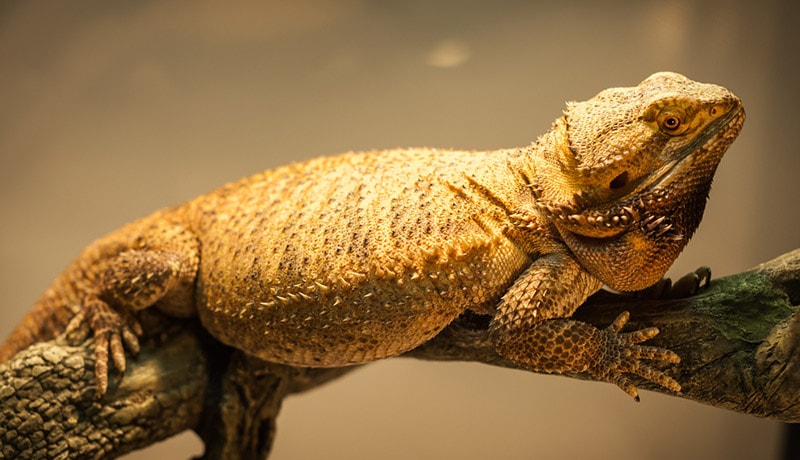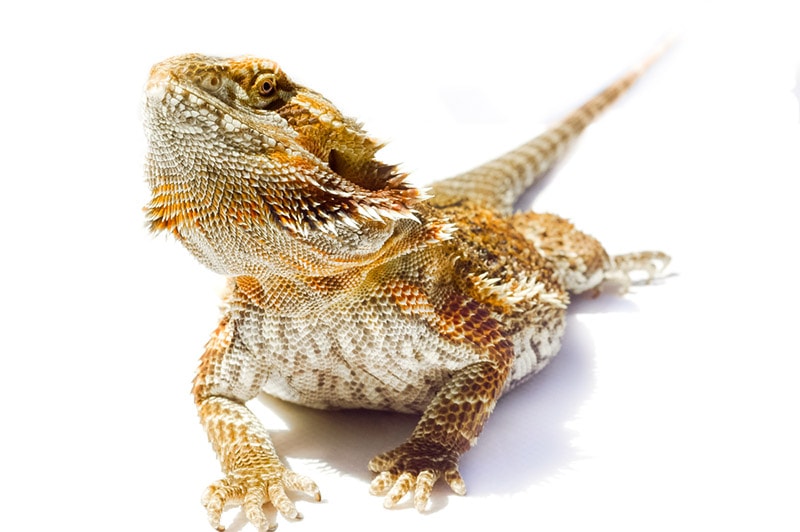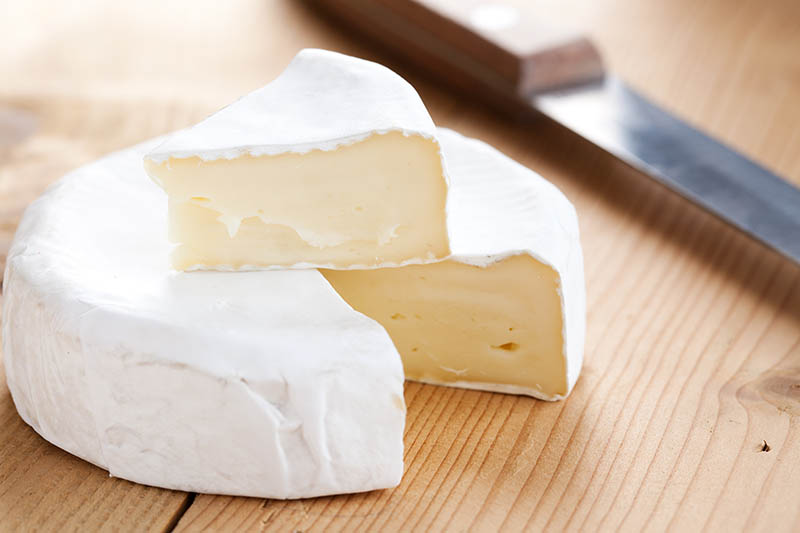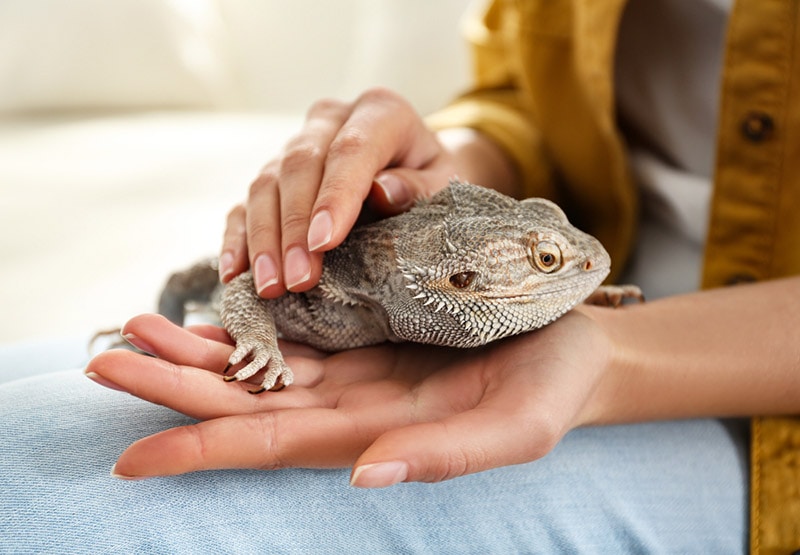German Giant Bearded Dragon: Size, Pictures, Habitat & Care Guide
Updated on

The German Giant Bearded Dragon is a sight to behold. While they can be intimidating at first, these lizards are docile, friendly, and can make excellent pets. Learn more about them right here!
Quick Facts About the German Giant Bearded Dragon
| Species Name: | Pogona |
| Common Name: | Bearded dragon |
| Care Level: | Low to medium maintenance |
| Lifespan: | 4–5 years |
| Adult Size: | Up to 30 inches long |
| Diet: | Omnivorous |
| Minimum Tank Size: | 100 gallons |
| Temperature & Humidity: | 70–130°F, low humidity |
Do German Giant Bearded Dragons Make Good Pets?
Yes, German Giant Bearded Dragons can make excellent pets. These are not pets like cats and dogs, as they do not show emotions through purring and cuddling, and their companionship is less “personal”. However, they also do not require nearly as intensive care as cats and dogs. Bearded dragons do tend to like laying on their human companions to feel the warmth of their bodies, which is typically an enjoyable experience for anyone involved.
These animals also don’t mind playing by interacting with things such as balls, mirrors, stuffed animals, and even scraps of cardboard. They also seem to enjoy things like watching television, going on walks, and even swimming. So, the bottom line is that German Giant Bearded Dragons are a fun and easy pet to take care of for kids and adults alike.

Appearance
German Giant Bearded Dragons are some of the largest pet lizards on the planet. The males can grow up to 3 feet in length and weigh up to 3 pounds when they are fully grown! Their unique coloring typically includes shades of yellow, gray, and red, although their overall look is usually light in color, similar to salmon or tan. Their eyes usually feature a mixture of silver and gold coloring, although they can be the more typical lizard eye color, which is yellow.
How to Take Care of a German Giant Bearded Dragon
Just because the German Giant Bearded Dragon is easier to take care of than a cat or dog doesn’t mean that there aren’t some basic care requirements that all owners should follow to ensure a happy and healthy life for their pet lizards.
Habitat, Tank Conditions & Setup
It is important to make sure that you’ve set up a suitable habitat (tank) for your new pet German Giant Bearded Dragon for them to live in when you bring them home for the first time.
| Tank Recommendations | |
| Tank Type: | 100-gallon glass tank |
| Lighting: | Overhead UV lighting |
| Heating: | Heating pad/tape on the bottom of enclosure and/or heat emitter |
| Best Substrate: | Newspaper, ceramic tiles, reptile carpet |
Here’s what you will need to set up the perfect reptile habitat for your German Giant:
Tank
The German Giant Bearded Dragon’s home should be a tank of at least 100 gallons, and the more space the merrier. After all, these animals might be small when first brought home, but they grow quickly into staggering 3-foot lizards that need plenty of room to roam when enclosed in their habitat.
The habitat should be outfitted with some items to help keep your pet bearded dragon happy and healthy as time goes on. Some tree branches, rocks, and logs should be present for perching on. A curved piece of bark or a commercially crafted cave are awesome options for hiding in.
A large, shallow bowl full of water should always be available for bathing and to help maintain humidity levels in the habitat. It’s a good idea to feed your bearded dragon in a bowl instead of on the floor of the habitat for health reasons. The tank habitat should be cleaned weekly with a reptile-safe disinfectant spray.
First, take all the décor and items out of the tank. Then, clear the substrate and debris out of the tank, using a handheld vacuum device if necessary, and spray the tank with disinfectant. While the tank dries, rinse the décor and water/food dishes in clean water. Once everything dries, you can put the tank habitat back together again and place your pet back in their home.
Lighting
Your German Giant Bearded Dragon would love to sit under a heated light during the day, as they require extra warmth to maintain their body heat. A basic basking light designed for reptile habitats is a great option, but the light cannot be used at night because these reptiles are diurnal, which means that they sleep at night as we do. Therefore, they will need another heating source to rely upon during nighttime hours, which we will discuss next.
Heating (Temperature & Humidity)
Heating mats like the Zilla Terrarium Reptile Heater that can be installed underneath your pet’s tank will help to keep them warm during the night while they sleep. These types of heaters can be connected to a thermostat so that you can maintain full control over tank temperatures.
Ceramic heat emitters, like this one by Fluker’s, are another option to consider. This is an aerial heating system that warms things up for your reptile pet from above like the sun naturally does in the wild.
Your pet’s habitat should have a “cool end” and a “hot end,” which basically means that half the tank should remain cooler than the other half. The temperatures that German Giant Bearded Dragons prefer are as follows:
| Cool End of the Tank: | 7–78°F |
| Hot End of the Tank: | 100–107°F |
Source: RSPCA
You will need to keep a thermometer inside the tank to measure temperature levels as time goes on.
Substrate
It’s crucial to cover the floor of your reptile’s habitat with some kind of substrate for improved humidity control, natural air filtration, and comfort. There are multiple great options to choose from including:
Newspaper – It’s affordable, easy to shred at home, and it’s easy to clean clumps of it up when necessary, without having to replace the entire substrate.
Reptile Carpet – This product can be cut to create a custom fit, is absorbent, and can’t accidentally get ingested by your German Giant Bearded Dragon. Most reptile carpets are washable and reusable.
Ceramic Tiles – These can be found at any home improvement store, and they offer traction for bearded dragons on the move. They are also durable so they shouldn’t need replacing unless accidentally broken during washing.
Feeding Your German Giant Bearded Dragon
German Giant Bearded Dragons are omnivorous and feed on a diet of live insects, fruits, and vegetables. They can and should eat a wide variety of foods to maintain a happy and healthy life. These foods include:
Insects: Crickets, mealworms, grasshoppers, earthworms, waxworms
Fruits: Berries, peaches, apples, melons, papayas
Vegetables: Bell peppers, cucumbers, carrots, broccoli, cauliflower, cilantro, kale, arugula, swiss chard, dandelion greens
| Diet Summary | |
| Fruits: | About 10% of diet |
| Insects: | About 70% of diet |
| Meat: | About 20% of diet |
| Supplements Required: | N/A |
Keeping Your German Giant Bearded Dragon Healthy
German Giant Bearded Dragons should be easy to care for if their habitat is kept clean and warm enough. Feeding them a couple of times a day and spending time with them outside of their habitat where they can get some exercise are the basics that will make or break your pet’s overall quality of life. Regular checkups by a veterinarian are also recommended.
While these large lizards are generally healthy, they are susceptible to the same kind of health problems that smaller lizards are. Knowing about these problems is the first step to identifying if and when a problem develops during your pet’s lifetime.
- Respiratory Infections – Excessive moisture in a bearded dragon’s habitat can cause upper respiratory problems that could become serious, and at worst, deadly. The signs of respiratory infections in these animals include bubbling sounds while breathing, excessive sneezing, and breathing through an open mouth.
- Metabolic Bone Disease – If your bearded dragon’s diet lacks an adequate amount of vitamin D and calcium, it can result in the development of this disease. Symptoms include bone deformities, excessive muscle twitching, and brittle bones.
- Infectious Stomatitis – This disease is commonly referred to as mouth rot, as it is an infection that affects the guns and creates a gum-covering mucus that looks like cottage cheese.
Lifespan
Sadly, the German Giant Bearded Dragon has a shorter lifespan of about 4 to 5 years compared to that of the smaller dragons with a lifespan of up to 12 years. Many things can play a role in the lifespan of a bearded dragon, such as the cleanliness and quality of their habitat, quality of food, quality of exercise, and quality of relationships with human companions.
Breeding
Breeding German Giant Bearded Dragons is a complicated process that requires intricate care and attention to detail. It is extremely easy to overbreed, which can have serious consequences for the health of all the babies involved. There is also a risk of problems such as malnourishment and respiratory distress when breeding these animals outside of the proper setting and without the proper procedures put into place. Therefore, we do not recommend breeding your pet bearded dragon at any point.
Are German Giant Bearded Dragons Friendly? Our Handling Advice
Yes, these large reptile pets are friendly and enjoy being handled! The typical German Giant Bearded Dragon enjoys laying on their companion’s lap and chest to feel their body warmth. They also like to be gently held for short periods while spending time outside of their habitat.
Our best tip is to handle your pet on their terms. If they don’t seem to want the handling, put them back in their habitat and try again later. Always be gentle when picking up, holding, and putting down your pet.
Shedding & Brumation: What to Expect
Brumation occurs during the winter months when they can’t keep themselves warm. After all, these are cold-blooded animals and have no way of internally controlling their body temperatures. So, when it gets too cold, they essentially go to sleep and stop using energy to keep themselves in a state that can survive in the cold.
This process is similar to hibernation that many mammals do. During this time, these lizards do not eat and rarely move if at all.
It’s also important to note that German Giant Bearded Dragons do go through a shedding season. Fully grown bearded dragons shed only about twice a year, at which time they literally release their skin to make room for new growth. Giving your pet warm baths to keep their skin moist while they shed can help make the process easier on them.
How Much Do German Giant Bearded Dragons Cost?
The typical German Giant Bearded Dragon can range in price from $300 to $500 depending on the breeder. Younger pets tend to cost less than those that are fully grown.
It’s important to keep in mind that the cost of the pet does not include such things as the habitat, food, dishes, and initial veterinarian visit, all of which should be considered when budgeting to get a new German Giant Bearded Dragon as a household pet.
Care Guide Summary
- Docile nature
- Friendly
- Easy to handle
- Requires a large habitat
- Requires constant heating
- Goes through multiple shedding seasons a year
Conclusion
German Giant Bearded Dragons can make great pets for kids and adults alike. They do require some attention and care, but that’s all part of the fun of being a pet owner. What’s most important is that you can commit to the care of such an animal before deciding whether to bring one home.
Featured Image Credit: valleyboi63, Shutterstock









